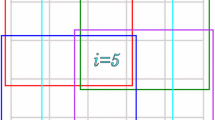Abstract
The existing spatially variant apodizations (SVAs) either cannot depress the sidelobes effectively or reduce the energy of the mainlobe. To improve this, a modified SVA (MSVA) is put forward in this paper, which expands the traditional filter from 3-taps to 5-taps and sets relevant parameters according to different sampling rates to get the excellent result that satisfies constrained optimization theory. A modified super-SVA is also presented, which compares the result after the iteration with the original signal and makes the one whose amplitude is smaller as the initial value of the next iteration. This method can eliminate the sidelobes produced by the intermediate operation, so that the following bandwidth extrapolation is more available. Super-MSVA is presented based on the modified SVA and modified super-SVA, which is suitable for any Nyquist sampling rate, can extrapolate the signal bandwidth many times through iteration with a commensurate improvement in resolution, as demonstrated by the result of the experiment.
Similar content being viewed by others
References
Cumming I G, Wong F H. Digital Processing of Synthetic Aperture Radar Data: Algorithms and Implementation. Norwood: Artech House, 2005. 21–112
Nuttall A H. Some windows with very good sidelobe behavior. IEEE Trans Acoust Speech Signal Process, 1981, 29(1):84–91
Zhang X Y, Su W M, Shi J, et al. Application of apodization filtering sidelobe suppression technique to synthetic aperture radar. J Electron Inf Technol, 2008, 30(4):902–905
Kwan H K, Lee C K. A neural network approach to pulse radar detection. IEEE Trans Aerosp Electron Syst, 1993, 29(1):9–21
Stankwitz H C, Dallaire R J, Fienup J R. Spatially variant apodization for sidelobe control in SAR imagery. In: Record of the 1994 IEEE National Radar Conference. Atlanta: IEEE, 1994. 132–137
Xu X J, Narayanan R M. SAR image enhancement using noninteger nyquist SVA technique. In: IEEE Antennas and Propagation Society International Symposium. San Antonio: IEEE, 2002, 4:298–301
Stankwitz H C, Kosek M R. Sparse aperture fill for SAR using super-SVA. In: Proceedings of 1996 IEEE Radar Conference. Ann Arbor: IEEE, 1996. 70–75
Castillo-Rubio C, Romano S L, Burgos-Garcia M. Spatially variant apodization for squinted synthetic aperture radar images. IEEE Trans Image Process, 2007, 16(8):2023–2027
Zhai W S, Zhang Y H. Apply spatially variant apodization to SAR/INSAR image processing. In: 1st Asian and Pacific Conference on Synthetic Aperture Radar. Huangshan: IEEE, 2007. 54–57
Xu X J, Narayanan R M. Enhanced resolution in SAR/ISAR imaging ssing iterative sidelobe apodization. IEEE Trans Image Process, 2005, 14(4):537–547
Fischer J, Pupeza I, Scheiber R. Sidelobe suppression using the SVA method for SAR images and sounding radars. In: EUSAR 2006. Dresden: vde-verlag.de, 2006
Stankwitz H C, Dallaire R J, Fienup J R. Nonlinear apodization for sidelobe control in SAR imagery. IEEE Trans Aerosp Electron Syst, 1995, 31(1):267–279
Smith B H. Generalization of spatially variant apodization to noninteger nyquist sampling rates. IEEE Trans Image Process, 2000, 9(6):1088–1093
Castillo-Rubio C, Romano S L, Burgos-Garcia M. Robust SVA method for every sampling rate condition. IEEE Trans Aerosp Electron Syst, 2007, 43(2):571–580
Jain A K. Fundamentals of Digital Image Processing. Upper Saddle River: Prentice Hall, 1989. 233–266
Borison S L, Bowling S B, Cuomo K M. Super-resolution methods for wideband radar. Lincoln Lab J, 1992, 5(3):441–461
Stankwitz H C, Taylor S P. Super-resolution for SAR/ISAR RCS measurement using spatially variant apodization (super-SVA). In: Antenna Measurement Techniques Association 17th Annual Meeting & Symposium. Williamsburg: AMTA, 1995. 251–256
Hu L J, Ding X D, Sun X J. Mathematical Experiment: Using MATLAB. Shanghai: Shanghai Scientific & Technical Publishers, 2001. 131–156
Jiang Q Y, Xing W X, Xie J X, et al. Experiments in Advanced Mathematics. Beijing: Tsinghua University Press, 2005. 137–193
Berizzi F, Corsini G. Autofocusing of inverse synthetic aperture radar images using contrast optimization. IEEE Trans Aerosp Electron Syst, 1996, 32(3): 1185–1191
Author information
Authors and Affiliations
Corresponding author
Rights and permissions
About this article
Cite this article
Ni, C., Wang, Y., Xu, X. et al. A super-resolution algorithm for synthetic aperture radar based on modified spatially variant apodization. Sci. China Phys. Mech. Astron. 54, 355–364 (2011). https://doi.org/10.1007/s11433-010-4186-8
Received:
Accepted:
Published:
Issue Date:
DOI: https://doi.org/10.1007/s11433-010-4186-8




